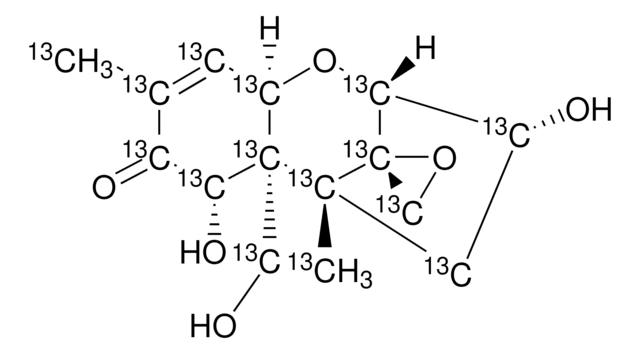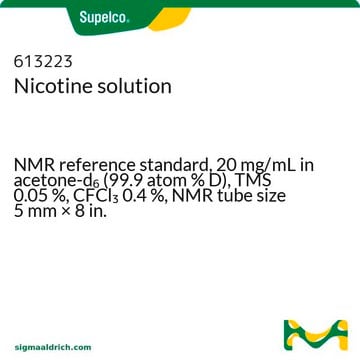36733
(−)-Nikotin
PESTANAL®, analytical standard
Synonym(e):
(−)-1-Methyl-2-(3-pyridyl)pyrrolidin, (S)-3-(1-Methyl-2-pyrrolidinyl)pyridin, L-(−)-3-(N-Methyl)-α-pyrrolidyl)-pyridin
About This Item
Empfohlene Produkte
Qualität
analytical standard
Qualitätsniveau
Produktlinie
PESTANAL®
Haltbarkeit
limited shelf life, expiry date on the label
Methode(n)
HPLC: suitable
gas chromatography (GC): suitable
Brechungsindex
n20/D 1.5265 (lit.)
Dichte
1.010 g/mL at 20 °C (lit.)
Anwendung(en)
agriculture
cleaning products
cosmetics
environmental
food and beverages
personal care
Format
neat
SMILES String
CN1CCC[C@H]1c2cccnc2
InChI
1S/C10H14N2/c1-12-7-3-5-10(12)9-4-2-6-11-8-9/h2,4,6,8,10H,3,5,7H2,1H3/t10-/m0/s1
InChIKey
SNICXCGAKADSCV-JTQLQIEISA-N
Angaben zum Gen
human ... CHRNA2(1135) , CHRNA4(1137) , CHRNB2(1141)
Suchen Sie nach ähnlichen Produkten? Aufrufen Leitfaden zum Produktvergleich
Verwandte Kategorien
Anwendung
Biochem./physiol. Wirkung
Rechtliche Hinweise
Signalwort
Danger
Gefahreneinstufungen
Acute Tox. 1 Oral - Acute Tox. 2 Dermal - Acute Tox. 2 Inhalation - Aquatic Chronic 2 - Eye Dam. 1 - Skin Irrit. 2
Lagerklassenschlüssel
6.1A - Combustible acute toxic Cat. 1 and 2 / very toxic hazardous materials
WGK
WGK 3
Flammpunkt (°F)
213.8 °F - closed cup
Flammpunkt (°C)
101 °C - closed cup
Persönliche Schutzausrüstung
Eyeshields, Faceshields, Gloves, type ABEK (EN14387) respirator filter
Choose from one of the most recent versions:
Besitzen Sie dieses Produkt bereits?
In der Dokumentenbibliothek finden Sie die Dokumentation zu den Produkten, die Sie kürzlich erworben haben.
Kunden haben sich ebenfalls angesehen
Protokolle
Test your food for fipronil contamination using our analytical standards, certified reference materials, solvents, and columns for analysis.
Unser Team von Wissenschaftlern verfügt über Erfahrung in allen Forschungsbereichen einschließlich Life Science, Materialwissenschaften, chemischer Synthese, Chromatographie, Analytik und vielen mehr..
Setzen Sie sich mit dem technischen Dienst in Verbindung.










